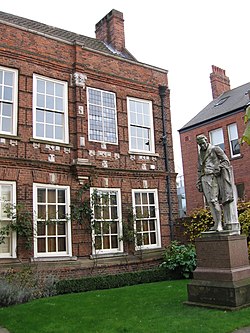Wilberforce House

Wilberforce House is the birthplace of William Wilberforce (1759–1833), the British politician, abolitionist and social reformer, located in the High Street, Kingston upon Hull, England. Like the nearby Blaydes House and Maister House, the building was formerly a Merchant's house with access to quayside on the River Hull. It is now part of Hull's Museums Quarter incorporating the Nelson Mandela garden.[1]
William Wilberforce was MP for Kingston upon Hull and was most influential in the abolition of slavery in Great Britain and its colonies, which became his life's work. The house is now a museum showcasing the life and work of one of Hull's most famous sons. It is also classified as a Grade I listed building.[2] The museum re-opened on 25 March 2007, after a two-year £1.6 million redevelopment, in time for the 200th anniversary of Wilberforce's Act of Parliament abolishing the slave trade in the British Empire.[3]
The new exhibition has a broad focus on the history of slavery in addition to items relating to the life and work of Wilberforce. The front garden to the museum contains a statue of Wilberforce which underwent a £10,000 restoration in 2011.[4] The statue was designated a Grade II* in 1994 and is now recorded in the National Heritage List for England, maintained by Historic England.[5] Adjoining the site is Oriel Chambers, the home of the University of Hull's Wilberforce Institute for the Study of Slavery and Emancipation which conducts research into historic and contemporary forms of slavery.[6]
The house also exhibits the East Yorkshire regimental collection.[7]
References[]
- ^ Davies, Andrew John (1 August 1995). "site unseen Wilberforce House, Hull". The Independent. Independent Print Limited. Retrieved 12 July 2010.
- ^ Historic England. "Wilberforce House Museum and Attached Garden Wall (1209831)". National Heritage List for England. Retrieved 14 August 2013.
- ^ "Grant boost for work on anti-slavery museum". Yorkshire Post. 7 October 2005. Retrieved 18 November 2019.
- ^ "William Wilberforce statue in £10,000 restoration". BBC News Online. BBC. 12 June 2011. Retrieved 13 June 2011.
- ^ Historic England. "Statue of William Wilberforce in Garden of Wilberforce House (1197754)". National Heritage List for England. Retrieved 14 August 2013.
- ^ "Wilberforce Institute for the study of Slavery and Emancipation". WISE. University of Hull. 25 February 2011. Retrieved 14 August 2013.
- ^ "Wilberforce House Galleries". Hull City Council. Retrieved 18 November 2019.
External links[]
| Wikimedia Commons has media related to Wilberforce House. |
- Official site
- Historic England. "Details from listed building database (1209831)". National Heritage List for England.
Coordinates: 53°44′40″N 0°19′48″W / 53.744461°N 0.330073°W
- Museums in Kingston upon Hull
- Historic houses in Kingston upon Hull
- Biographical museums in the East Riding of Yorkshire
- Grade I listed buildings in the East Riding of Yorkshire
- Grade I listed houses
- Historic house museums in the East Riding of Yorkshire
- Slavery museums
- English organisation stubs
- United Kingdom museum stubs
